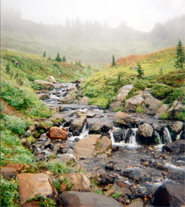2 May 2012
WASHINGTON—Despite a general increase in air temperatures over the past several decades, streams are not necessarily warming at the same rate, according to a new analysis of streams in the western United States using long-term monitoring programs.
Several factors may influence the discrepancy, researchers say, including snowmelt, interaction with groundwater, flow and discharge rates, solar radiation, wind and humidity. But even after factoring out those elements, the scientists were surprised by the cooler-than-expected maximum, mean and minimum temperatures of the streams.
Results of the research, which was supported by the U.S. Geological Survey, the U.S. Forest Service and Oregon State University in Corvallis, will be published May 16 in Geophysical Research Letters, a journal of the American Geophysical Union.
“Individually, you can find streams that seem to be getting warmer and others that are getting cooler,” said Ivan Arismendi, a post-doctoral researcher at Oregon State University and lead author on the study. “Some streams show little effect at all. But the bottom line is that recent trends in overall stream temperature do not parallel climate-related trends.”
The researchers caution that the findings do not mean that climate change will not have an impact on stream temperature, which is a fundamental driver of ecosystem processes in streams. However, the relationship between air temperatures and stream temperatures may be more complex than previously realized and require additional monitoring.
Alternatively, there may be a time lag between air temperature and stream temperature, the researchers said.
“One surprise was how few stream gauging stations have the necessary long-term records for evaluating climate-related trends in water temperatures,” said coauthor Jason Dunham, an aquatic ecologist with the U.S. Geological Survey in Corvallis, Ore. “Most of them are located in streams with high human influence, which makes it difficult to separate climate effects from local human impacts.”
“In those areas where human impact was minimal, the variability in trends was impressive,” added Dunham. “It suggests to us that a variety of local influences may strongly affect how stream temperatures respond to climate.”
Arismendi and his colleagues considered more than 600 gauging stations for the study but only 20 of the stations had a sufficiently lengthy period of monitoring – and lacked human influence. These long-term monitoring sites are operated primarily by the U.S. Geological Survey and U.S. Forest Service, and were located in Oregon, Washington, Idaho, California, Nevada and Alaska.
Warming temperatures can create more rapid or earlier snowmelt and affect stream temperatures in some locations, said coauthor Roy Haggerty, a professor in OSU’s College of Earth, Ocean, and Atmospheric Sciences. Another explanation for the lack of warming in many streams could be a time lag that can occur between precipitation entering underground aquifers and entering the stream.
“Groundwater can influence stream temperatures as well as stream flow and in some cases, it can take many years for that groundwater to make it to the stream,” noted Haggerty. “This and the other physics processes of a stream need to be considered when analyzing its heat budget – from the geology and stream bed, to the amount of shading in the riparian zone.”
Sherri Johnson, a research ecologist with the U.S. Forest Service, also in Corvallis, and coauthor on the study, said stream temperatures can be important for a variety of reasons.
“Temperature is a key indicator of water quality and many streams throughout the Northwest have increased stream temperatures associated with human activity,” Johnson said. “Generally speaking, cooler stream temperatures are beneficial, and are a crucial factor in maintaining healthy ecosystems and populations of salmon, steelhead, trout and other cold-water species.”
Arismendi said the study points out the value of long-term data from streams that have had minimal human impacts.
“The fact that stream temperatures don’t correlate to climate trends in a predicable way indicates we need to study the relationship further to better appreciate the complexity,” Arismendi said. “Our knowledge of what influences stream temperatures is limited by the lack of long-term monitoring sites, and previous lumping of results among streams with relatively low and high levels of human impacts.
“Local variability is really important in driving climate sensitivity of streams,” he added.
AGU Contact:
Kate Ramsayer, +1 (202) 777-7524, [email protected]
Oregon State Contact:
Mark Floyd, +1 (541) 737-0788, [email protected]
Journalists and public information officers (PIOs) of educational and scientific institutions who have registered with AGU can download a PDF copy of this paper in press.
Or, you may order a copy of the final paper by emailing your request to Kate Ramsayer at [email protected]. Please provide your name, the name of your publication, and your phone number.
Neither the paper nor this press release are under embargo.
“The paradox of cooling streams in a warming world: Regional climate trends do not parallel variable local trends in stream temperature in the Pacific continental United States”
Ivan Arismendi
College of Earth, Ocean, and Atmospheric Sciences, Oregon State University, Corvallis, Oregon, USA;
Sherri Johnson
US Forest Service Pacific Northwest Research Station, Corvallis, Oregon, USA;
Jason Dunham
US Geological Survey, Forest and Rangeland Ecosystem Science Center, Corvallis, Oregon, USA;
Roy Haggerty
College of Earth, Ocean, and Atmospheric Sciences, Oregon State University, Corvallis, Oregon, USA;
David Hockman-Wert
US Geological Survey, Forest and Rangeland Ecosystem Science Center, Corvallis, Oregon, USA.
Ivan Arismendi, email: [email protected], telephone: 541-750-7443; Sherri Johnson, email:[email protected], telephone: 541-758-7771; Jason Dunham, email: [email protected], telephone: 541-750-0990; Roy Haggerty, email: [email protected], telephone: 541-737-1210.
